“I’m gonna call it, right now”, he declared — he being a restaurateur, one of a group of eight or so — “Napa 2.0.” He smirked and locked eyes with two or three peers for effect over a glass of Riesling — one of countless many consumed over a three-day stay in the Finger Lakes of upstate New York, where a purported wine renaissance is underway.
“Napa 2.0.” Say it aloud and you can taste the hashtag, like a bitter tannin. I was lodging at the Harvest House, a B&B in which a handful of restaurant industry players and journalists are invited to stay every year to aid in working the land during the autumn grape harvest, to drink and to network, usually all at once. When you bring hip Williamsburg restaurateurs to wine country, you get buzzword generation and wine-buzzed chain smoking on the porch.
As for myself: aside from the obvious, I was just looking forward to the fresh air, a respite from city smog. Prior to the trip upstate I had only seen Finger Lakes wines at stands in NYC farmers markets. My girlfriend recently bought a bottle for her parents. It was blue like that necklace from Titanic, its watercolor label hinting at rolling hills. The couple who sold it to her were farmers, looking characteristically sturdy in their worn windbreakers, smiling with friendly wrinkles.
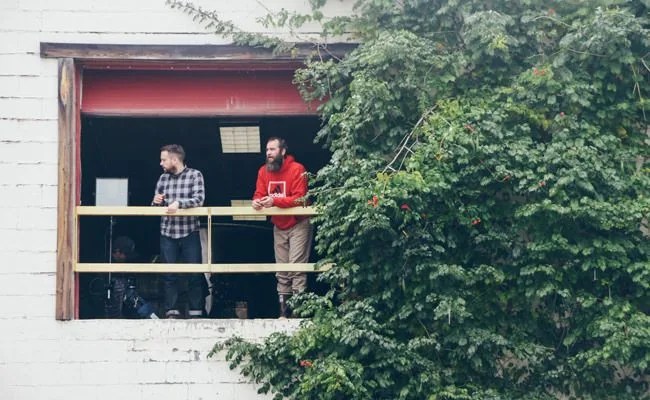
After a prolonged bout of snobbery in the first hour of the visit — at a breakfast held by Casa Larga, a family winery — those expectations became skewed. I mentioned a popular fruit winery in my hometown to a fellow guest, and his mouth twisted as though from a sour taste; he cut me off and said, in a French accent so stereotypical that I nearly renounced my entire liberal arts education, “Well, fruit wine is not real wine.” Then he slurped his way through every bottle they served us as the poor vintner gave a speech, every splash of wine on his teeth like a little slap in its winemaker’s face. Later, when I asked the President of the New York Wine & Grape Association, during his spiel, whether Hurricane Sandy had affected the Finger Lakes region along with last year’s polar vortex, he waved my question off — “No, I wouldn’t say so” — and continued along with his bullet points. Now I was the one with the sour look on his face; like a teen tasting his first sip of merlot, I was ready to immediately reject what had been offered me despite its initial allure.
A glass of Riesling tastes different sipped from a porch overlooking a vineyard rather than in a crowded, anonymously trendy wine bar.
I came around when we got to the vineyards themselves. If you’re fortunate enough to live within visiting distance of a farm, you might know the vibe of the area: locals rent out the farmers’ spaces for weddings, and the farmers sell the locals’ charmingly cheesy art in said spaces during business hours. And most everyone gets from A to B in a truck. It sounds downright quaint because it is. And that quaintness is what makes it the best possible place to both craft, drink and learn about wine. A glass of Riesling tastes different sipped from a porch overlooking a vineyard — backdropped by a sprawling lake and an endless sky — rather than in a crowded, anonymously trendy wine bar. Conversations about the relationship between climate, soil and grapes can only mean so much without the grapes in question sitting in your hands, or being chewed in your mouth.
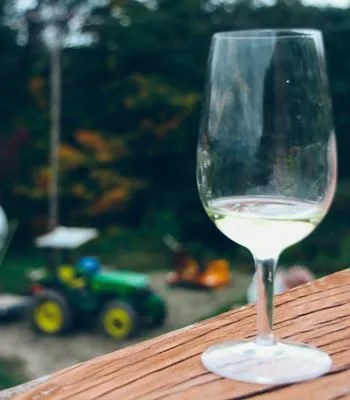
The Finger Lakes have been home to a handful of wineries for decades, but are only recently attracting serious mainstream interest. The eleven lakes are collectively a recognized as an American Viticultural Area by the Alcohol and Tobacco Tax and Trade Bureau, though Canandaigua, Keuka, Conesus, Hemlock, Seneca and Cayuga (both independent AVAs on their own) are where most of the magic happens. Thanks to their immense depth, Seneca and Cayuga act as heat sources during the winter, which extends the growing season for their 60-odd wineries; the region gained notoriety for its climatic similarities to the German Rhine, the origin of the Riesling and Gewürztraminer styles with which the lakes are associated. The wine industry here has swelled slowly since the Farm Winery Act was passed in 1976, allowing grape growers to build wineries and sell wine directly to the public sans distributors.
And after gaining some momentum in the ‘90s, the Finger Lakes region may be nearing its true boom. Just last year the Wall Street Journal named the region “one of the most dynamic wine regions in America today”, fingering the low cost of land (a fraction of the cost of Napa) as a big draw for the “new wave of young winemakers staking a claim in the Finger Lakes”, while New York Times wine critic Eric Asimov declared that “No American wine-growing region excites me about Riesling as much as the Finger Lakes of New York.” He added: “The region is just beginning to discover a sense of its own potential. With time, these wines are going to get better and better.” And indeed, Wine Spectator’s list of Finger Lakes wines already boasts some pretty respectable scores — not to mention that prior to all the published praise last year, Finger Lakes wine was served at the President’s inaugural luncheon in 2013. With a little over 100 wineries spread across 11,000 acres — and an increasing number of them run by transplants from California (often Napa itself), Europe and elsewhere — it’s safe to say the area is officially blowing up.
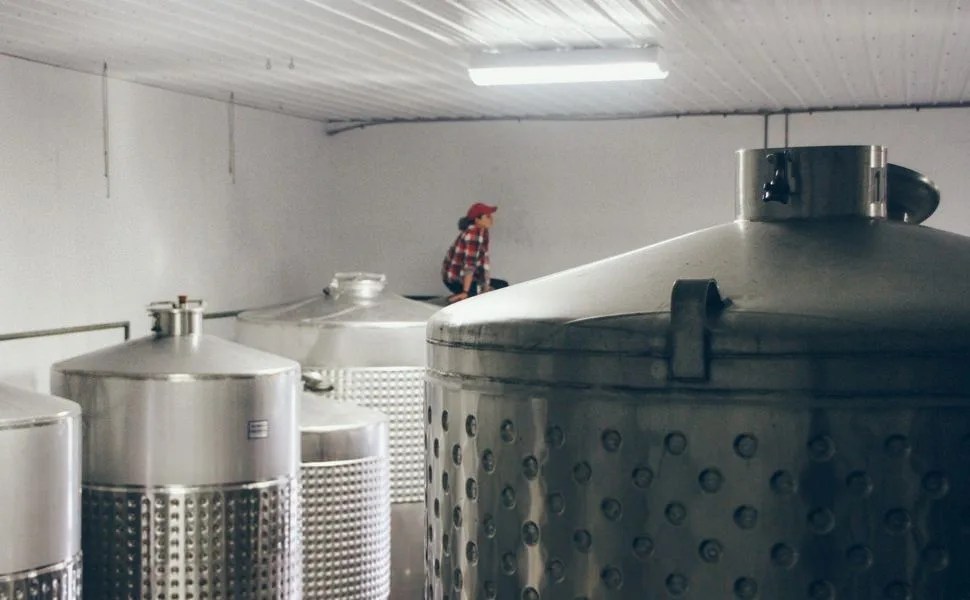
During harvest season, larger, more established wineries draw interested parties from up and down the East Coast, who then disperse themselves among the smaller vineyards. Locals from surrounding towns (Ithaca, Rochester and Syracuse) have their particular loyalties. The winemakers themselves, meanwhile, are loyal to the region and to each other; those same tourist-magnet big wineries regularly rent out fermentation tanks, presses and other such equipment to smaller operations whose grape yields exceed the capacities of their current equipment.
The region’s flagship products, which countless regional papers and national wine publications have praised, remain Rieslings and Gewürztraminers of varying levels of dryness. But more and more wineries are branching out with their varietal selection and experimenting with region-specific styles; for example, Casa Larga sells an ice wine made from Cabernet Franc grapes that freeze on the vine on the coldest days. It’s a syrupy dessert wine with brandy-like warmth, and Casa Larga infuses the style with characteristically Finger Lakes aromatics.
Locals from surrounding towns have their particular loyalties — the winemakers themselves, meanwhile, are loyal to the region and to each other.
But being a longstanding fixture of the region, Casa Larga can’t quite match the experimental verve of smaller crafters like Keuka Lake Vineyards, situated on the only lake that isn’t shaped like a finger; its namesake lake roughly resembles a wishbone. Having perfected a stable of dry and semi-dry Rieslings since the late ‘90s, Keuka Lake’s respective founder and winemaker, Mel Goldman and Moss Bitner, are slowly introducing reds and less common styles into their repertoire.
Which is not to discount their more traditional fare. Their 2012 semi-dry Riesling, a favorite of mine, is a ninja smoke bomb of a wine: its inscrutably acidic nose betrays nothing of the explosion of minerality that awaits, which vanishes on the heels of a sweet, citrusy finish. But once the Finger Lakes Riesling formality was through, Goldman won the group over by leading us down a rabbit hole of experimentation and surprises. Up until this stop, the group’s comments were mainly comprised of observational tasting notes delivered with the intensity of Jeopardy contestants; upon tasting a newly finished orange wine — named for the color, not for the fruit — genuine enthusiasm took hold. We marveled at the staining that a fermenting Pinot exhibited on our sampling glasses. And one seemingly innocuous batch of red wine was unlike anything I had ever tasted: downright pickly on first blush, with a finish that strongly evoked pico de gallo, of all things.
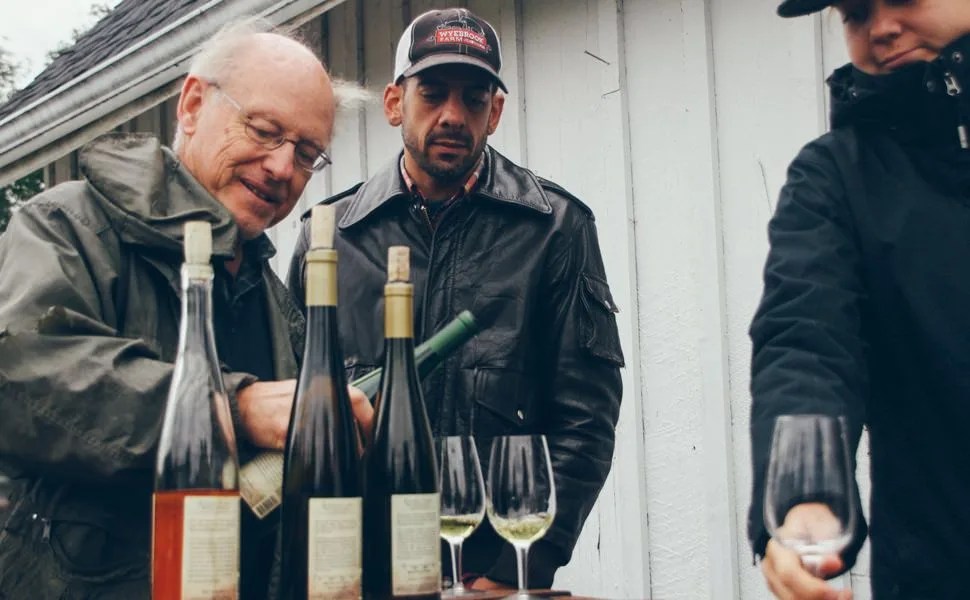
Goldman and Bitner seek to branch out to many different styles: they tried making their own brandy — “too aromatic”, Goldman said mournfully — and a “port-like” wine. “We tried to call it a port, but they wouldn’t let us”, he said with a smirk, referring to the laws regulating wine label nomenclature based on the contents of the bottle, “so we named it Hammondsport”, a nod to the surrounding neighborhood. Goldman’s experimentalism stems from the width of his experience. Born in Brooklyn, he joined the Peace Corps in his early adulthood to develop farms in Nepal, and later studied winemaking in Israel. Such stories were common among the winemakers I met; behind the quaint veneer was a formidable worldliness.
Just a few minutes north from Keuka Lake Vineyards is Dr. Konstantin Frank Vinifera, where I tasted my first white wine grape. Fred Frank — a descendent of the original Frank family that founded the winery — handed us individual Gewürztraminer and Riesling grapes to taste for ripeness: underripe grapes had unbreakable seeds, their juice dry and somewhat bitter — ironically not unlike dry Riesling — while ripe grapes’ skin broke easily between teeth, loosing equally soft seeds and sweet, floral juice.
He paired us off and sent us through the vineyards to gather grapes and spot botrytus cinerea, a viral fungus that, in consistently wet conditions, saps and disintegrates grapes into a sort of dusty mold. But in situations where dry weather follows rain, the fungus actually dries the fruit and leaves the sugar, which works to sweeten the wine; this effect is called “noble rot”. The winery’s end goal being dry Riesling, our job was to remove the fungus — so I tramped off with my partner, plastic bins in hand. The grape-gathering was meant as a competition — the pair who gathered the most was to be awarded a bottle of Gewürztraminer — but as surly men don’t often pair well, we skipped the bonding exercise and mostly just tasted grapes.
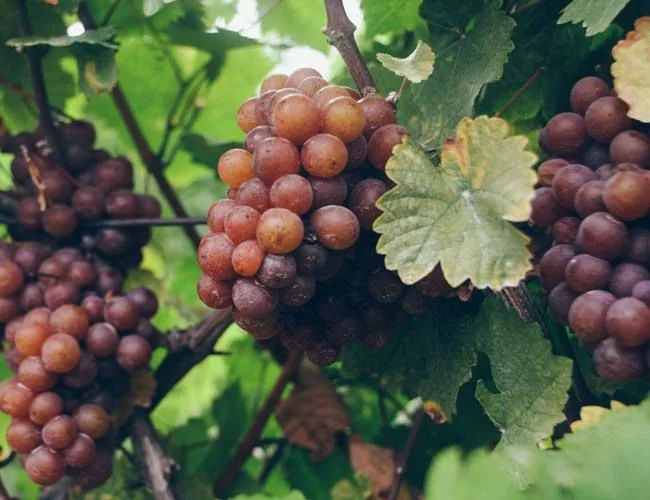
Dr. Frank, as the group called it, is something of a legacy operation, one of the founding wineries of the region. Keuka Lake Vineyard, meanwhile, is a bit scrappier. “We’re short of space this year”, Goldman had explained to us as we huddled between the misty steel fermentation tanks. “We started growing these grapes in 1997, and really started planting seriously in 1998… this is the first year we’re going to really start making a profit. But then, we’ll have to get bigger tanks… these tanks are dairy tanks that we bought from the farmers.” Mel’s method of cold stabilization for white wines is to simply open up the doors and let the cool air in. It may seem somewhat less than professional. But younger businesses like Mel’s were what the group turned out to be most interested in. Establishments like Dr. Frank and Casa Larga were regarded the way a New Yorker treats the Metropolitan Museum of Art when a touristy family member visits. One visitor even speculated that the latter’s outdated label art was to blame for their bottles’ hardship in the marketplace. Younger wineries founded in the ‘90s, like Fox Run and Red Newt, were the most talked about.
Some Wine Terms
Brix: The measure of sugar in a body of liquid, measured by a hydrometer. (Checking Brix levels can often involve tasting — which has no bearing on the math involved.) 1 degree of Brix indicates 1 gram of sugar per 100 grams of juice; to estimate the level of alcohol that fermenting juice will produce, multiply the Brix reading by 0.55.
Chaptalization: The process of adding sugar to juice before or during fermentation. In cold climates like that of the Finger Lakes, chaptalization can be necessary to compensate for underripe (and therefore less sugary) grapes.
Residual sugar: Grams of unfermented sugar in a finished wine product per liter of wine, abbreviated “g/L”, or simply “RS”.
Cold Stabilization: The cooling of fermentation tanks prior to bottling, usually by running cool water through channels that line the wall of the tanks, in order to let crystalized solids float to the top of the tank, where they can be removed.
Maceration: The steeping of grape skins in fermenting juice (typically red), which lends the eventual product color, tannins and aroma.
Orange Wine: A white wine variety, the production of which involves prolonged maceration.
Noble Rot: The beneficial variety of Botrytis cinerea, which typically occurs when dry conditions follow rain.
Dry Rot: The unwanted form of Botrytis, typically occurring in consistently wet conditions.
I got to work with Fox Run for the second day of my visit, where Mel showed up, a twinkle in his eye, to drop off a few large crates of Riesling. His surplus was such that he needed to rent out the much larger winery’s considerably large grape press, as well as one of their fermentation tanks, which was roughly twice the size of his. I had been dropped off along with a partner, a cook from The Dutch, an eatery in downtown Manhattan; Peter Bell, Fox Run’s head winemaker, acknowledged us with just a nod from the mouth of the fermentation room — while Fleetwood Mac drifted from big speakers over the grind of pumps and presses — and led us up to the lab. We watched him give an assistant winemaker, Sarah Gummoe, the rundown on the day’s work. Pointing out different tanks on a whiteboard floor plan, he held his marker over one tank, represented by a circle, and turned to face my partner and me.
“What’s the term for adding sugar to a fermentation tank to regulate the alcohol level? Anyone know?” Suddenly I was back in chemistry class, half asleep, straining to remember last night’s reading. “Chapta-what?” he hinted. With the two of us stumped, Sarah chimed in: “Chaptalization.”
Later on, as we were siphoning a drum full of sugar water into a towering tank, my partner remarked that she was “pretty happy” with the girl power on staff here. From atop the tank, I saw Liyuan, an exchange student of sorts from China (which is experiencing a wine boom similar to our own), driving a forklift; one of the winery’s two female owners was conversing with coworkers by the entrance; outside, Gummoe was overseeing the destemmer. And those who weren’t driving forklifts or operating pumps were working the tasting room a mile or two away.
It’s a trend that echoes Napa, though little else here does. Like the hallowed Valley, the Finger Lakes is neighbors with a massive metropolis — but whereas Napa wines are readily available in San Francisco, LA, and San Diego, and most anywhere in the country, Finger Lakes wines have yet to penetrate significantly into New York City. Larger wineries like Fox Run and Red Newt are increasingly relying on distribution for their profits, rather than visitors to the winery. As far as the Finger Lakes’ penetration into the NYC market, it’s a mixed bag: small wineries like Keuka Lakes have had some success, while legacy operations like Casa Larga have had historically had a hard time. So much for going local.
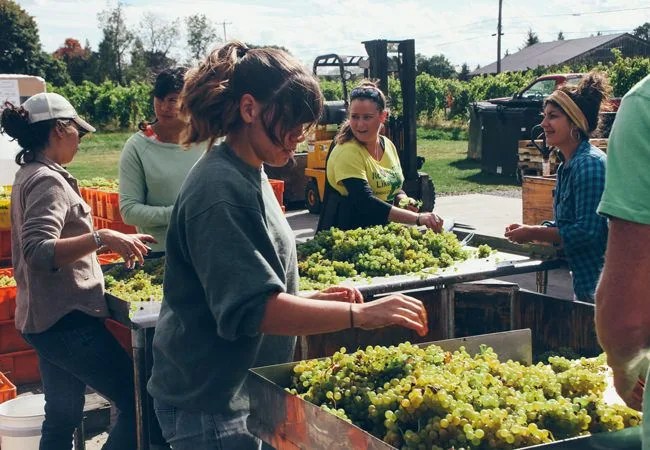
“Distribution is maybe 60, 65 percent of our profits”, Red Newt winemaker Kelby Russell told me on my visit to Red Newt the next day. “And it’s growing.” Yet distribution is not without its challenges, which he described to me on a drive to the vineyards. “Pennsylvania’s impossible because of state legislation; you have to make it through the bureaucracy of ‘tasting panels’… and we had a bad experience with a distributor in Connecticut. They had a great sales pitch, but they don’t care about us; we’re kind of languishing in their books.” Red Newt has only a handful of carriers in NYC — despite moving “a boatload of wine through Massachusetts”, which Russell finds “surprising, but encouraging”.
He drove me past a dozen-odd farmhouses and cellars, and explained that “the wineries that are realizing what the potential market is out there are making the transition” from a focus on tasting rooms to distribution. “It requires you to be a different company. If your market is more than just the local market… you’re protected a little more from economic swings.” He assured me that smaller, tasting room-centric operations, like Keuka Lake Vineyards, could generally ride out such a storm. The community would be there for them — the loyal locals and bigger players alike. A vine, in other words, can grow and weather the seasons with a little help. But the bigger companies must play a bigger and more complicated game.
“That’s Pompous Ass Winery” — he pointed out a long, narrow building flanked by a sign bearing a cartoon donkey in a dandy suit and suspenders. “Their thing is that they make wines that aren’t pretentious…incidentally their wines aren’t very good.” In other words: not “Napa 2.0” material.
Over a lavish dinner I learned that Finger Lakes vintners and non-vintners alike take just about every cause du jour to heart in a way that puts urbanites (myself included) to shame. Every ingredient of the meal was locally sourced. And whereas New Yorkers (as in city-dwellers) have heard about fracking off and on so often it’s a wonder if any of them truly know what it is, it’s a genuine threat to the local livelihood in the Finger Lakes. According to local chef Brud Holland, who prepared our meals nightly, “It’s only gonna create 8 jobs and maybe put $200,000 in the county’s tax coffers.” We all listened while sipping on a tarragon liqueur he had infused himself. “Meanwhile, Doug Hazlitt — he owns Hazlitt Winery up on Seneca Lake — he pays, like, a million in taxes. It’s like, are you kidding me? Why are you here? Who are you paying?” The battle against fracking has been won, but now there’s a new threat: hollowed-out caverns near the shores of Seneca Lake, from the Finger Lakes’ salt mining days, have caught the eye of fuel companies searching for a convenient place to store propane gas. Accompanying concerns of leaking gas is the possibility that the project could push salt from the caverns out into Seneca Lake, which is already the saltiest lake in the region. And so much depends on that lake — namely, the thousands of acres of vines growing alongside it.
A food blogger from the visiting group spoke up: “But you guys all have something to bandy behind. It’s more optimistic for you guys in that sense.” Then my former grape picking partner spoke up: “Well the state should be standing up for all these vineyards if they’re generating all this money.”
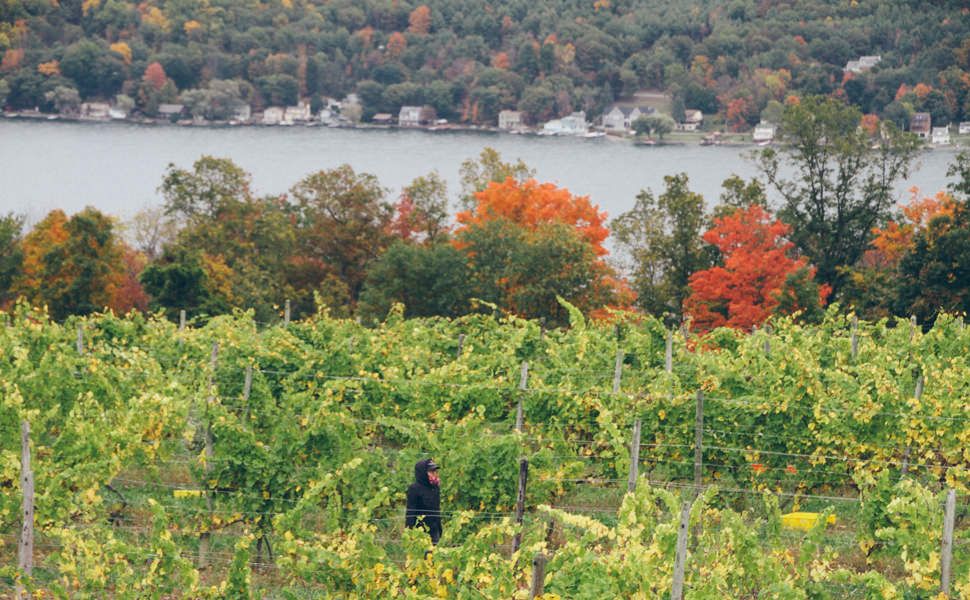
“It’s ‘big against small’ again, that’s all it is”, Brud sighed, “the David and Goliath story — classic.” But, he added, Governor Cuomo was on their side. “He’s totally behind everything we do…and the Lieutenant Governor, Duffy, he’s done in a month or two — he’s totally sick of politics, he bought a house up here. I’ve done a couple dinners for him. He basically said, ‘enough already…’ He bought a house on Keuka Lake.”
I wouldn’t call the Finger Lakes a David or a Goliath. Within the community there are Davids and Goliaths, without the Biblical antagonism: less of the stones and slings, more of the standing on shoulders. Maybe that community is a David compared to its predecessors, compared to other industries — and maybe with some help it can become a Goliath.
After dinner I sat out on the porch with the rest of the group, Frenchie asleep in a wicker chair beside me, I too tipsy to avoid the secondhand smoke. We talked about all the wines we had tasted. Trading stories in which they got dirt under their fingernails, my fellow foodies and restaurateurs seemed to care more — and that much became clear as I watched them exchange business cards with winery representatives. I showed them a sunburn I’d gotten picking botrytis in Red Newt’s vineyards; I’d been slightly overzealous in snipping out every dash of fuzz I could find. “Napa 2.0”: Hopefully, like the noble rot, these New Yorkers can help to sweeten the region instead of drying it to ashen dust.
